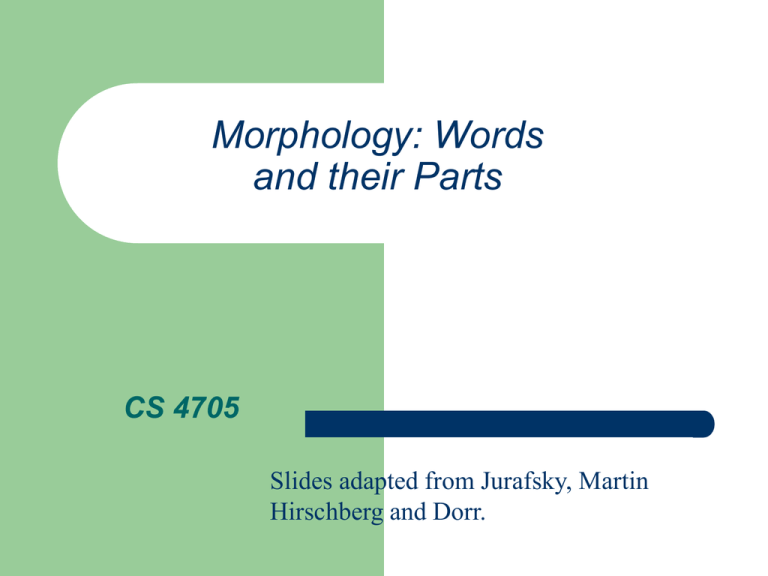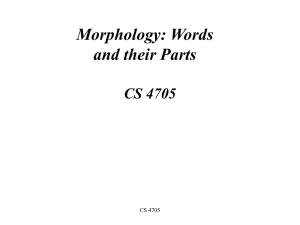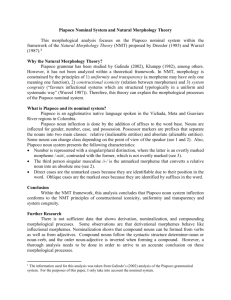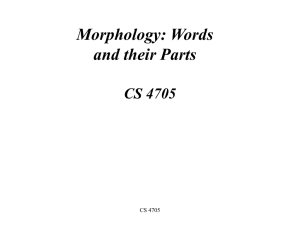Morphology: Words and their Parts CS 4705 Slides adapted from Jurafsky, Martin
advertisement

Morphology: Words and their Parts CS 4705 Slides adapted from Jurafsky, Martin Hirschberg and Dorr. English Morphology Morphology is the study of the ways that words are built up from smaller meaningful units called morphemes We can usefully divide morphemes into two classes – – Stems: The core meaning bearing units Affixes: Bits and pieces that adhere to stems to change their meanings and grammatical functions Nouns and Verbs (English) Nouns are simple (not really) – Markers for plural and possessive Verbs are only slightly more complex – Markers appropriate to the tense of the verb Regulars and Irregulars Ok so it gets a little complicated by the fact that some words misbehave (refuse to follow the rules) – – Mouse/mice, goose/geese, ox/oxen Go/went, fly/flew The terms regular and irregular will be used to refer to words that follow the rules and those that don’t. Regular and Irregular Nouns and Verbs Regulars… – – Walk, walks, walking, walked, walked Table, tables Irregulars – – – – Eat, eats, eating, ate, eaten Catch, catches, catching, caught, caught Cut, cuts, cutting, cut, cut Goose, geese Why care about morphology? – Spelling correction: referece Morphology in machine translation – – – Hyphenation algorithms: refer-ence Part-of-speech analysis: google, googler Text-to-speech: grapheme-to-phoneme conversion – Spanish words quiero and quieres are both related to querer ‘want’ hothouse (/T/ or /D/) Allows us to guess at meaning ‘Twas brillig and the slithy toves… Muggles moogled migwiches Concatenative Morphology Morpheme+Morpheme+Morpheme+… Stems: often called lemma, base form, root, lexeme – hope+ing hoping hop hopping Affixes – – – – Prefixes: Antidisestablishmentarianism Suffixes: Antidisestablishmentarianism Infixes: hingi (borrow) – humingi (borrower) in Tagalog Circumfixes: sagen (say) – gesagt (said) in German What useful information does morphology give us? Different things in different languages – – Spanish: hablo, hablaré/ English: I speak, I will speak English: book, books/ Japanese: hon, hon Languages differ in how they encode morphological information – – Isolating languages (e.g. Cantonese) have no affixes: each word usually has 1 morpheme Agglutinative languages (e.g. Finnish, Turkish) are composed of prefixes and suffixes added to a stem (like beads on a string) – each feature realized by a single affix, e.g. Finnish epäjärjestelmällistyttämättömyydellänsäkäänköhän ‘Wonder if he can also ... with his capability of not causing things to be unsystematic’ – – Inflectional languages (e.g. English) merge different features into a single affix (e.g. ‘s’ in likes indicates both person and tense); and the same feature can be realized by different affixes Polysynthetic languages (e.g. Inuit languages) express much of their syntax in their morphology, incorporating a verb’s arguments into the verb, e.g. Western Greenlandic Aliikusersuillammassuaanerartassagaluarpaalli. aliiku-sersu-i-llammas-sua-a-nerar-ta-ssa-galuar-paal-li entertainment-provide-SEMITRANS-one.good.at-COP-say.that-REPFUT-sure.but-3.PL.SUBJ/3SG.OBJ-but 'However, they will say that he is a great entertainer, but ...' – So….different languages may require very different morphological analyzers What we want Something to automatically do the following kinds of mappings: Cats cat +N +PL Cat cat +N +SG Cities city +N +PL Merging merge +V +Presentparticiple Caught catch +V +past-participle Morphology Can Help Define Word Classes AKA morphological classes, parts-of-speech Closed vs. open (function vs. content) class words – – Pronoun, preposition, conjunction, determiner,… Noun, verb, adverb, adjective,… Identifying word classes is useful for almost any task in NLP, from translation to speech recognition to topic detection…very basic semantics (English) Inflectional Morphology Word stem + grammatical morpheme different forms of same word – – Usually produces word of same class Usually serves a syntactic or grammatical function (e.g. agreement) like likes or liked bird birds Nominal morphology – Plural forms s or es Irregular forms (goose/geese) – Mass vs. count nouns (fish/fish(es), email or emails?) Possessives (cat’s, cats’) Verbal inflection – Main verbs (sleep, like, fear) relatively regular – -s, ing, ed And productive: emailed, instant-messaged, faxed, homered But some are not: – eat/ate/eaten, catch/caught/caught Primary (be, have, do) and modal verbs (can, will, must) often irregular and not productive – Be: am/is/are/were/was/been/being Irregular verbs few (~250) but frequently occurring Derivational Morphology Word stem + syntactic/grammatical morpheme new words – – Usually produces word of different class Incomplete process: derivational morphs cannot be applied to just any member of a class Verbs --> nouns – – – -ize verbs -ation nouns generalize, realize generalization, realization synthesize but not synthesization Verbs, nouns adjectives – – Adjective adverb – embrace, pity embraceable, pitiable care, wit careless, witless happy happily Process selective in unpredictable ways – – – Less productive: nerveless/*evidence-less, malleable/*sleep-able, rar-ity/*rareness Meanings of derived terms harder to predict by rule clueless, careless, nerveless, sleepless Compounding Two base forms join to form a new word – – Bedtime, Weinerschnitzel, Rotwein Careful? Compound or derivation? Morphotactics What are the ‘rules’ for constructing a word in a given language? – – – Pseudo-intellectual vs. *intellectual-pseudo Rational-ize vs *ize-rational Cretin-ous vs. *cretin-ly vs. *cretin-acious Semantics: In English, un- cannot attach to adjectives that already have a negative connotation: – – – Unhappy vs. *unsad Unhealthy vs. *unsick Unclean vs. *undirty Phonology: In English, -er cannot attach to words of more than two syllables – – – – – great, greater Happy, happier Competent, *competenter Elegant, *eleganter Unruly, ?unrulier Morphological Parsing These regularities enable us to create software to parse words into their component parts Morphology and FSAs We’d like to use the machinery provided by FSAs to capture facts about morphology • • • Ie. Accept strings that are in the language And reject strings that are not And do it in a way that doesn’t require us to in effect list all the words in the language What do we need to build a morphological parser? Lexicon: list of stems and affixes (w/ corresponding p.o.s.) Morphotactics of the language: model of how and which morphemes can be affixed to a stem Orthographic rules: spelling modifications that may occur when affixation occurs – in il in context of l (in- + legal) Most morphological phenomena can be described with regular expressions – so finite state techniques often used to represent morphological processes Start Simple Regular singular nouns are ok Regular plural nouns have an -s on the end Irregulars are ok as is Simple Rules Now Add in the Words Derivational morphology: adjective fragment adj-root1 unq0 -er, -ly, -est q1 q2 adj-root1 q3 q5 q4 -er, -est adj-root2 • Adj-root1: clear, happi, real (clearly) • Adj-root2: big, red (*bigly) Parsing/Generation vs. Recognition We can now run strings through these machines to recognize strings in the language • • But recognition is usually not quite what we need • • Accept words that are ok Reject words that are not Often if we find some string in the language we might like to find the structure in it (parsing) Or we have some structure and we want to produce a surface form (production/generation) Example • From “cats” to “cat +N +PL” Finite State Transducers The simple story • • • Add another tape Add extra symbols to the transitions On one tape we read “cats”, on the other we write “cat +N +PL” Applications The kind of parsing we’re talking about is normally called morphological analysis It can either be • • An important stand-alone component of an application (spelling correction, information retrieval) Or simply a link in a chain of processing FSTs Kimmo Koskenniemi’s two-level morphology Idea: word is a relationship between lexical level (its morphemes) and surface level (its orthography) Transitions c:c a:a t:t +N:ε +PL:s c:c means read a c on one tape and write a c on the other +N:ε means read a +N symbol on one tape and write nothing on the other +PL:s means read +PL and write an s Typical Uses Typically, we’ll read from one tape using the first symbol on the machine transitions (just as in a simple FSA). And we’ll write to the second tape using the other symbols on the transitions. In general, FSTs can be used for – – – Translators (Hello:Ciao) Parser/generators (Hello:How may I help you?) As well as Kimmo-style morphological parsing Ambiguity Recall that in non-deterministic recognition multiple paths through a machine may lead to an accept state. • Didn’t matter which path was actually traversed In FSTs the path to an accept state does matter since differ paths represent different parses and different outputs will result Ambiguity What’s the right parse (segmentation) for • • • Unionizable Union-ize-able Un-ion-ize-able Each represents a valid path through the derivational morphology machine. Ambiguity There are a number of ways to deal with this problem • • • Simply take the first output found Find all the possible outputs (all paths) and return them all (without choosing) Bias the search so that only one or a few likely paths are explored The Gory Details Of course, its not as easy as • “cat +N +PL” <-> “cats” As we saw earlier there are geese, mice and oxen But there are also a whole host of spelling/pronunciation changes that go along with inflectional changes • • Cats vs Dogs Fox and Foxes Multi-Tape Machines To deal with this we can simply add more tapes and use the output of one tape machine as the input to the next So to handle irregular spelling changes we’ll add intermediate tapes with intermediate symbols Generativity Nothing really privileged about the directions. We can write from one and read from the other or vice-versa. One way is generation, the other way is analysis Multi-Level Tape Machines We use one machine to transduce between the lexical and the intermediate level, and another to handle the spelling changes to the surface tape Lexical to Intermediate Level Intermediate to Surface The add an “e” rule as in fox^s# <-> foxes# Foxes Note A key feature of this machine is that it doesn’t do anything to inputs to which it doesn’t apply. Meaning that they are written out unchanged to the output tape. Overall Scheme We now have one FST that has explicit information about the lexicon (actual words, their spelling, facts about word classes and regularity). • Lexical level to intermediate forms We have a larger set of machines that capture orthographic/spelling rules. • Intermediate forms to surface forms Overall Scheme Cascades This is a scheme that we’ll see again and again. • • • Overall processing is divided up into distinct rewrite steps The output of one layer serves as the input to the next The intermediate tapes may or may not wind up being useful in their own right Porter Stemmer (1980) Used for tasks in which you only care about the stem – IR, modeling given/new distinction, topic detection, document similarity Lexicon-free morphological analysis Cascades rewrite rules (e.g. misunderstanding --> misunderstand --> understand --> …) Easily implemented as an FST with rules e.g. – ATIONAL ATE – ING ε Not perfect …. – Doing doe Policy police Does stemming help? – – IR, little Topic detection, more Summing Up FSTs provide a useful tool for implementing a standard model of morphological analysis, Kimmo’s two-level morphology But for many tasks (e.g. IR) much simpler approaches are still widely used, e.g. the rule-based Porter Stemmer Next time: – Read Ch 4 HW1 assigned; see web page: http://www.cs.columbia.edu/~kathy/NLP





